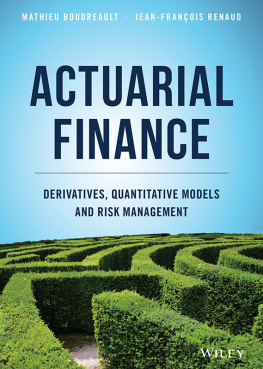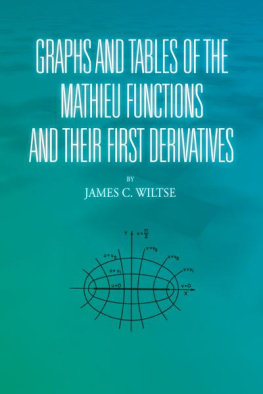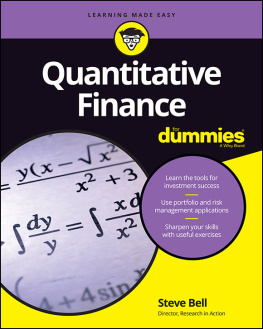Boudreault Mathieu - Actuarial finance : derivatives, quantitative models and risk management
Here you can read online Boudreault Mathieu - Actuarial finance : derivatives, quantitative models and risk management full text of the book (entire story) in english for free. Download pdf and epub, get meaning, cover and reviews about this ebook. year: 2019, publisher: John Wiley & Sons, genre: Business. Description of the work, (preface) as well as reviews are available. Best literature library LitArk.com created for fans of good reading and offers a wide selection of genres:
Romance novel
Science fiction
Adventure
Detective
Science
History
Home and family
Prose
Art
Politics
Computer
Non-fiction
Religion
Business
Children
Humor
Choose a favorite category and find really read worthwhile books. Enjoy immersion in the world of imagination, feel the emotions of the characters or learn something new for yourself, make an fascinating discovery.
- Book:Actuarial finance : derivatives, quantitative models and risk management
- Author:
- Publisher:John Wiley & Sons
- Genre:
- Year:2019
- Rating:4 / 5
- Favourites:Add to favourites
- Your mark:
- 80
- 1
- 2
- 3
- 4
- 5
Actuarial finance : derivatives, quantitative models and risk management: summary, description and annotation
We offer to read an annotation, description, summary or preface (depends on what the author of the book "Actuarial finance : derivatives, quantitative models and risk management" wrote himself). If you haven't found the necessary information about the book — write in the comments, we will try to find it.
Actuarial finance : derivatives, quantitative models and risk management — read online for free the complete book (whole text) full work
Below is the text of the book, divided by pages. System saving the place of the last page read, allows you to conveniently read the book "Actuarial finance : derivatives, quantitative models and risk management" online for free, without having to search again every time where you left off. Put a bookmark, and you can go to the page where you finished reading at any time.
Font size:
Interval:
Bookmark:

Mathieu Boudreault and Jean-Franois Renaud
Universit du Qubec Montral, Canada

This edition first published 2019
2019 John Wiley & Sons, Inc.
All rights reserved. No part of this publication may be reproduced, stored in a retrieval system, or transmitted, in any form or by any means, electronic, mechanical, photocopying, recording or otherwise, except as permitted by law. Advice on how to obtain permission to reuse material from this title is available at http://www.wiley.com/go/permissions.
The right of Mathieu Boudreault and Jean-Franois Renaud to be identified as the authors of this work has been asserted in accordance with law.
Registered Office
John Wiley & Sons, Inc., 111 River Street, Hoboken, NJ 07030, USA
Editorial Office
111 River Street, Hoboken, NJ 07030, USA
For details of our global editorial offices, customer services, and more information about Wiley products visit us at www.wiley.com.
Wiley also publishes its books in a variety of electronic formats and by print-on-demand. Some content that appears in standard print versions of this book may not be available in other formats.
Limit of Liability/Disclaimer of WarrantyWhile the publisher and authors have used their best efforts in preparing this work, they make no representations or warranties with respect to the accuracy or completeness of the contents of this work and specifically disclaim all warranties, including without limitation any implied warranties of merchantability or fitness for a particular purpose. No warranty may be created or extended by sales representatives, written sales materials or promotional statements for this work. The fact that an organization, website, or product is referred to in this work as a citation and/or potential source of further information does not mean that the publisher and authors endorse the information or services the organization, website, or product may provide or recommendations it may make. This work is sold with the understanding that the publisher is not engaged in rendering professional services. The advice and strategies contained herein may not be suitable for your situation. You should consult with a specialist where appropriate. Further, readers should be aware that websites listed in this work may have changed or disappeared between when this work was written and when it is read. Neither the publisher nor authors shall be liable for any loss of profit or any other commercial damages, including but not limited to special, incidental, consequential, or other damages.
Library of Congress Cataloging-in-Publication data is available for this book.
9781119137009 (hardback)
Cover Design: Wiley
Cover Image: precinbe/iStock.com
Jolle, Justine, Raphal et Thomas
Julie, tienne et Anne-Sophie
We are deeply grateful to our families for their unconditional support.
Special thanks to Genevive Gauthier, Carole Bernard and Christiane Lemieux for their impact on our first years of teaching this material. Many thanks to colleagues from both academia and industry who took some of their precious time to review one or several chapters of earlier versions of the book: (in alphabetical order) Maciej Augustyniak, Jean-Franois Bgin, Bruno Gagnon, Ron Gebhardtsbauer, Jonathan Grgoire, Anne MacKay, Clarence Simard, Tommy Thomassin and Marie-Claude Vachon. Your comments were greatly appreciated and helped improve our book.
We also wish to thank the students who have attended our lectures for their feedback. This book is for you.
Finally, warm thanks to Jean-Mathieu Potvin for turning our handwritten plots into beautiful TikZ figures, to Christel Jackson Book for carefully reviewing each and every example and exercise, and to Adel Benlagra who also contributed to solve and revise exercises in the first half of the book. All remaining errors and typos are ours.
The work of actuaries has been strongly impacted by the deregulation of financial markets and the financial innovation that followed. Nowadays, there are embedded options in many life insurance and annuity products. Moreover, the use of weather and catastrophe derivatives in P&C insurance, to manage losses from earthquakes, hurricanes, floods and extreme weather, is constantly increasing, while longevity derivatives have been created to manage longevity risk on pools of pensioners.
As a consequence, in recent years actuarial finance has become an emerging field at the crossing of actuarial science and mathematical finance, i.e. when both actuarial and financial risks have to be taken into account. Despite its common roots with modern financial mathematics, actuarial finance has its own challenges due to:
- the very long-term nature (several years or decades) of insurance liabilities;
- the presence of mortality risk and other contingencies;
- the structure and regulations of the insurance and pension markets.
Therefore, it is now widely recognized that actuaries should have a basic knowledge of:
- derivatives and other assets to manage actuarial and financial risks;
- embedded options in actuarial liabilities.
As we are writing this book for the typical actuarial science (undergraduate) student or practitioner, our main goal is to find an appropriate balance between the level of mathematics and finance in the presentation of classical financial models such as the binomial tree and the Black-Scholes-Merton model. Given the growing complexity of many actuarial liabilities and their ties to financial markets, we also felt the need for a book with actuarial applications at the forefront.
Therefore, this book has been motivated, designed and written for actuaries (and by actuaries). This means that we spend more time on and put more energy into what matters to actuaries, i.e. topics of particular relevance for actuaries are introduced at a more accessible level and analyzed in greater depth. For example, in this book, we:
- compare pricing in insurance and financial markets;
- present credit default swaps which are largely used by insurance companies to manage credit risk and we compare them with term life insurance;
- discuss event-triggered derivatives such as weather, catastrophe and longevity derivatives and how they can be used for risk management;
- introduce equity-linked insurance and annuities (EIAs, VAs), relate them to common derivatives and describe how to manage mortality for these products;
- put more emphasis on replication in the (two-period and n-period) binomial model and in the Black-Scholes-Merton model to better grasp the origins of the so-called actuarial/real-world and risk-neutral probabilities (or the (in)famous
 and
and  measures);
measures); - implement and rebalance dynamic hedging strategies over several periods;
- introduce pricing and replication in incomplete markets and analyze the impact of market incompleteness on insurance and risk management;
Font size:
Interval:
Bookmark:
Similar books «Actuarial finance : derivatives, quantitative models and risk management»
Look at similar books to Actuarial finance : derivatives, quantitative models and risk management. We have selected literature similar in name and meaning in the hope of providing readers with more options to find new, interesting, not yet read works.
Discussion, reviews of the book Actuarial finance : derivatives, quantitative models and risk management and just readers' own opinions. Leave your comments, write what you think about the work, its meaning or the main characters. Specify what exactly you liked and what you didn't like, and why you think so.







